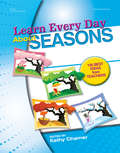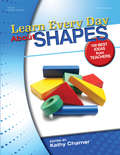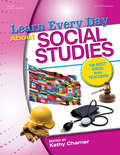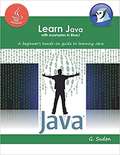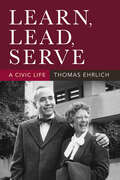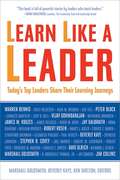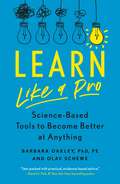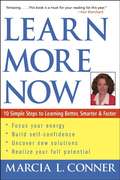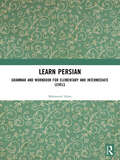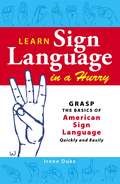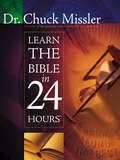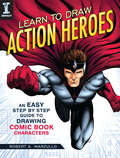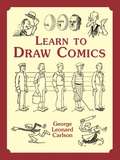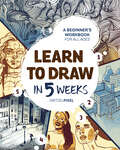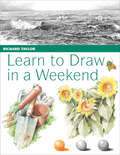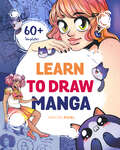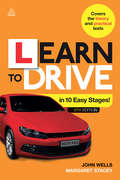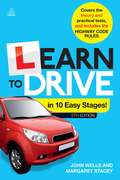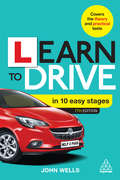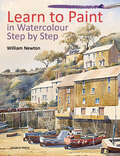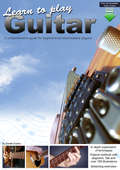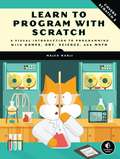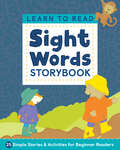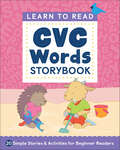- Table View
- List View
Learn Every Day About Seasons: 100 Best Ideas from Teachers
by Kathy CharnerNow teachers can bring the magic of each season into their classrooms with these activities that introduce children to the wonder of the seasons with a year full of fun! Classroom-tested teacher favorites, this book features activities that teach children to understand the difference between the seasons, as well as activities that can only be done during certain seasons. Children will love making paper cutout fall leaves, suns, and snowflakes as they celebrate the joy and excitement of the world outside all year long!
Learn Every Day About Shapes: 100 Best Ideas from Teachers
by Kathy CharnerLearning about shapes has never been so much fun!This new book features 100 activities all about shapes! Teachers and children alike will enjoy exploring the concept of shapes with activities such as Have You Seen My Square, The Circle in the Square, and Erase a Shape. The result of a nationwide contest, these activities are organized by curriculum area and offer fresh ideas that provide hours of engaging activities. Complete with learning objectives, related children's books, and an assessment component, teachers will find everything they need to teach children ages 3-6 all about shapes. Learn Every Day About Shapes is sure to become a classroom favorite!Each activity features: *Learning objectives *Related vocabulary *Related children's books *Materials needed *Directions for preparation *Instructions for each activity *An assessment component Many activities also feature teacher-to-teacher tips that provide additional ideas for expanding the activity in new ways, or suggestions about finding materials. You will also find related fingerplays, poems, or songs to extend children's learning.This book, like each of the other books in the Learn Every Day series, give teachers 100 classroom-tested activities that make learning fun and engaging for young children!
Learn Every Day About Social Studies: 100 Best Ideas from Teachers
by Kathy CharnerChildren are innately interested in their world. The activities in Learn Every Day About Social Studies invite children to explore the world around them, learn about different cultures, enjoy a variety of careers, and discover the uniqueness of their very own neighborhood. From the many ways we are alike and different to the variety of homes around the world, children will delve into these social studies activities that are perfect for children ages 3 to 6.
Learn Java With Examples In BlueJ: A Beginner's Hands-on Approach to Learning Java
by G. SudenLearn Java with examples in BlueJ, gets you started programming in Java right away. Learning a complex new language is not an easy task especially when it’s an object-oriented programming language like Java. This practical beginner’s guide enables you to: <P><P> Gain a solid understanding of Java. Understand difference between Procedure Oriented Programming (POP) and Object Oriented Programming (OOP). Teach you fundamental concepts of Object Oriented Programming, Objects and Classes. Each program shown with its associated output. Explanation of difficult lines of code. All programs compiled and executed in the BlueJ Development Environment. Extensive examples provided in each chapter. Empower you to develop logical and analytical thinking using object-oriented approach in Java. A hands-on and exercise-rich book in Java programming for beginners. Start brewing up great programs with Java! Knowledge of other programming languages is not required. Book designed to teach Java in readable style with small and direct programs making even arcane concepts clear.
Learn, Lead, Serve: A Civic Life
by Thomas EhrlichThomas Ehrlich served in the federal administrations of six presidents, beginning with Kennedy in 1962. He was also Dean of Stanford Law School, Provost of the University of Pennsylvania, President of Indiana University, and one of the pioneers of the service-learning movement. Weaving together memorable family stories and valuable professional insights, Ehrlich tells how he developed the knowledge and skills to be a leader in both government and higher education, the lessons he learned in those roles, and the many ways he and his wife Ellen balanced family life and civic service along the way. Warmly written and brimming with fascinating, behind-the-scenes details, Learn, Lead, Serve is both a celebration of an accomplished career and an inspiring lodestar for those wanting to follow the path of public service.
Learn Like a Leader: Today's Top Leaders Share Their Learning Journeys
by Marshall Goldsmith Beverly Kaye Ken SheltonWhy are some people able to grow in their careers while others never fully reach their potential? Learn Like a Leader explores this question by examining defining moments of leadership. The authors share personal stories gathered from great leaders such as James Collins, Warren Bennis, and Dave Ulrich, portraying the power of storytelling in training and mentoring.
Learn Like a Pro: Science-Based Tools to Become Better at Anything
by Barbara Oakley PhD Olav ScheweA book for learners of all ages containing the best and most updated advice on learning from neuroscience and cognitive psychology. Do you spend too much time learning with disappointing results? Do you find it difficult to remember what you read? Do you put off studying because it’s boring and you’re easily distracted? This book is for you.Dr. Barbara Oakley and Olav Schewe have both struggled in the past with their learning. But they have found techniques to help them master any material. Building on insights from neuroscience and cognitive psychology, they give you a crash course to improve your ability to learn, no matter what the subject is. Through their decades of writing, teaching, and research on learning, the authors have developed deep connections with experts from a vast array of disciplines. And it’s all honed with feedback from thousands of students who have themselves gone through the trenches of learning. Successful learners gradually add tools and techniques to their mental toolbox, and they think critically about their learning to determine when and how to best use their mental tools. That allows these learners to make the best use of their brains, whether those brains seem “naturally” geared toward learning or not. This book will teach you how you can do the same.
Learn More Now: 10 Simple Steps to Learning Better, Smarter, and Faster
by Marcia L. ConnerThis book is part road map, part blueprint, and part magical decoder ring, all rolled into one. The primary purpose of this book is to help you create a meaningful and fulfilling life by embracing the nature of continual learning. Its also about more than just learning. Learn More Now will help you become more aware, more focused, aligned with your natural pace, and improvisational in whatever you do. It will encourage you to learn your own life's lessons, and grow into your potential.
Learn Persian: Grammar and Workbook for Elementary and Intermediate Levels
by Mahmood AlamLearn Persian has a step-by-step organized and structured framework of modern Persian words; grammar, short syntactical phrases and idiomatic expressions. Persian has a lot of common words and sounds from Arabic and Urdu; this work highlights vowels and consonants that are covered in the formation of words and sounds with apt precision. The special feature of this book is its simplicity, yet meaningful and comprehensiveness for the study of the language. This should be a good source book for new learners, as well as for those who want to explore the harmony and flair of Persian. It would undoubtedly open doors to a Persian heritage as much as it slowly trains the eager learner in spoken Persian as well. Learn Persian will interest both learners and experts, and an excellent experience of coming across Persian as an interesting living language.
Learn Sign Language in a Hurry: Grasp the Basics of American Sign Language Quickly and Easily
by Irene Duke"I love you.""What can I get you?""Let's take a walk."Wanting to say simple things like these but not being able to is frustrating and disheartening-but learning how to communicate can be easy and fun! This book is a basic guide to the alphabet, vocabulary, and techniques it takes to connect using American Sign Language. Whether signing out of necessity or learning for the sake of growing, you will enjoy this practical primer. After reading this book, you will be able to use American Sign Language in a social, educational, or professional setting.Whether the goal is to communicate with hearing-impaired grandparent, a child with special needs in school, or an infant, people learn sign language for many different reasons. Easy to read and reference-and complete with images and examples of common signs-this basic guide allows you to make a meaningful connection that's otherwise impossible.
Learn the Bible in 24 Hours
by Chuck MisslerFor those who have tried and failed to follow through on a plan to study the entire Bible, Chuck Missler has the answer. Learn the Bible in 24 Hours is an ideal study aid to help you grasp the big picture of Scripture. Each chapter is designed for study in an hour or less. Features include: Sound, fresh teaching on Scripture Historical and cultural insight into biblical passages Sidebars that highlight the primary concepts of the chapter
Learn the Bible in 24 Hours
by Chuck MisslerScholars throughout the ages have devoted lifetimes to studying the Bible. But for most of us, this simply isn't practical or possible. For those who have tried and failed to initiate a program of personal Bible study, Learn the Bible in 24 Hours is ideal. Chuck Missler provides readers with the strategic grasp of the "big picture" of Scripture that enables them to ably navigate specific passages. Each chapter, designed as a one-hour session, features: Sound, fresh teaching on the design of Scripture Historical and cultural insight into biblical passages Sidebar text that highlights the primary concepts of the chapter Information on how to receive college credit from Louisiana Baptist University upon completion of the book is also included.
Learn to Draw Action Heroes: An Easy Step by Step Guide to Drawing Comic Book Characters
by Robert MarzulloIt's a bird! It's a plane! It's a superhero drawing book! Professional comic book artist and YouTube guru Robert Marzullo teaches you the building blocks of creating your own action heroes and explosive comic book scenes. Easy to follow step-by-step demonstrations break down advanced drawings into basic shapes and shading for you to replicate and master before applying your newfound knowledge to create your own dynamic comic book characters and settings. INCLUDES50+ step-by-step demonstrationsChapters on drawing faces, bodies, character details and scenesInstruction on depicting both superhuman men and women using different perspectives, expressions, proportions and posesIdeas for costumes, such as basic cuffs, capes, helmets, armor and weaponryTips for rendering power effects, from flying and wall smashing to magic-orb wielding and energy blastingLessons on blocking in a scene to create powerful comic panels that tell a story
Learn to Draw Comics
by George Leonard CarlsonThis user-friendly guide from the 1930s offers aspiring cartoonists a wealth of practical advice. Rich in period flavor, it supplies the ageless foundations of comic art. Abundant illustrations and clear, nontechnical prose cover: creating expressions, attaining proportion and applying perspective, depicting anatomy, simple shading, achieving consistency, lettering, and writing a strip.
Learn to Draw in 5 Weeks: A Beginner's Workbook for All Ages
by KRITZELPIXELMaster drawing basics in just five weeks with this workbook for beginners of all ages!The bestselling author of Manga Learning to Draw with Fun and Learn to Draw: Day-by-Day, Isabel B. Zimmerman (aka KritzelPixel), brings you a fun, beginner-friendly program to quickly grasp core drawing techniques. Each week, you&’ll develop a new skill, incorporating principles such as light, depth, and perspective into your evolving work. Whether you dream of being able to draw animals, humans, manga, or creating a comic book of your own, this workbook provides a template for how to gain confidence and see improvement right away.With Learn to Draw in 5 Weeks, you&’ll: Explore easy, step-by-step instructions: Learn the fundamentals of drawing through simple definitions, visual examples, and anecdotes from the author&’s experience. Access exclusive explanatory videos: QR codes throughout the book take you directly to author videos that further explain core drawing lessons.Complete fun daily exercises: Simple assignments will help improve your skill set week after week. Accessible prompts inspire you to put pen (or pencil!) to paper from Day 1!Become the artist you want to be! While art comes from the heart, this book provides all the technical skills you need for your foundation—in five short weeks.No matter your age or stage—whether you&’re a beginner or returning after a long time—Isabel B. Zimmermann offers tools to watch your skill set soar!
Learn to Draw in a Weekend
by Richard TaylorUnleash your inner artist in just a couple of days with this hands-on beginner&’s guide to drawing full of techniques, projects, and inspiration.Learn to Draw in a Weekend leads the reader through basic techniques and skill-building exercises to a variety of fully developed projects. Developing artists go from indoor drawing on Saturday to a beautiful Sunday of drawing outside. Beginning with simple shapes and lines drawings, they soon learn to add texture, depth, and color. Each project is packed with encouraging advice and helpful tips for a variety of drawing media, including graphite pencils, colored pencils, Conte, pastel, charcoal and watercolor pencils. The volume also features inspirational artworks, and professional advice from the author and acclaimed artist Richard Taylor.
Learn to Draw Manga: A Fun And Easy How-to Draw Guide For All Ages
by KRITZELPIXELBring out the artist in you with Learn to Draw Manga, an easy step-by-step guide to creating manga art.Do you have a fascination for manga or anime? Have you been excited to draw your favorite characters but unsure how to conjure them on the page? Welcome to the creative universe of Learn to Draw Manga, where you&’ll learn to turn your doodles into masterpieces in no time. Best-selling author of Learn to Draw in 5 Weeks, Isabel B. Zimmermann, aka KritzelPixel, brings you this user-friendly book that&’ll get you or a manga fan inspired to learn, grow, and succeed in the art of manga. Learn to Draw Manga offers: Easy step-by-step instructions with tips and anecdotes from the author&’s own experience as a manga artist and creator More than 60 easy-to-follow templates of various levels to meet you where you are Helpful illustrations so you can learn to draw details like eyes, noses, expressions, hairstyles, and more Fun learning techniques that emphasize the joy and satisfaction in creating art rather than focusing on innate talent Go beyond reading manga and become a creator yourself! Whether you're a beginner just venturing into drawing or an experienced artist looking for practice, Learn to Draw Manga is your friendly guide to the exhilarating world of manga art.
Learn to Drive in 10 Easy Stages
by Margaret Stacey Dr John WellsLearn to Drive is one of the most well established guides to preparing for and undergoing a driving test. This new edition contains everything that prospective students need to know - with both the theory and practical tests covered in this one volume. In full colour throughout, and with a wealth of new and updated illustrations, the guide is designed to be as user-friendly as possible and will ensure that readers are well prepared for their driving tests. The book includes a unique 10-step programme to help in preparing for the practical test as well as over 600 practice questions to help prepare for the theory test.
Learn to Drive in 10 Easy Stages
by Margaret Stacey John WellsLearn to Drive is one of the most well established guides to preparing for and undergoing a driving test. This new edition contains everything that prospective students need to know - with both the theory and practical tests covered in this one volume, as well as the relevant Highway Code rules. In full colour throughout, and with a wealth of new and updated illustrations, the guide is designed to be as user-friendly as possible and will ensure that readers are well prepared for their driving tests. The book includes a unique 10-step programme to help in preparing for the practical test; over 600 practice questions to help prepare for the theory test; and the Highway Code rules for all drivers.
Learn to Drive in 10 Easy Stages: Covers The Theory And Practical Tests (Kogan Page Ser.)
by Dr John WellsLearn to Drive in 10 Easy Stages is one of the most well-established guides to preparing for and undergoing a driving test. This new edition contains everything that prospective students need to know - with both the theory and practical tests covered in this one volume. In full colour throughout, and with a wealth of new and updated illustrations, the guide is designed to be as user-friendly as possible and will ensure that readers are well prepared for their driving tests. The book includes a unique 10-step programme to help in preparing for the practical test as well as over 600 practice questions to help prepare for the theory test.
Learn to Paint in Watercolour Step by Step
by William NewtonLearn how to paint relaxing landscapes, exciting seascapes and portraits with personality. Whatever you want to paint, William Newton can show you how. Starting from first principles, this thorough guide demonstrates the breadth and depth of William's watercolour painting expertise. In addition to beautiful detailed projects covering architecture, still life and other classic scenes, this book contains sections on colour and tone, the materials you will need, key watercolour painting techniques as well as vital information on perspective and drawing; all explained and illustrated for ease of use. This book was previously published as William Newton's Complete Guide to Watercolour Painting and is now made available in paperback.
Learn to Play Guitar: A Comprehensive Guitar Guide for Beginners to Intermediate Players
by Gareth Evans“Covers a wide range topics essential for all guitarists. Plenty of information and solid advice that a player can dip into as needed. There are many examples to practice with the backing tracks. A very useful tool to help you progress with your guitar playing." Hedley Timbs BA(Mus), Grad.Dip. Teaching (New Zealand) Learn to Play Guitar is comprehensive and clear with over 180 photographic examples, illustrations and purpose made diagrams. This guitar book includes 42 downloadable mp3 tracks of full band demo and backing track with the guitar removed for you to play over. Learn to Play Guitar bridges the gaps, explaining guitar techniques that can be taken for granted by more experienced guitar players.Melodies - To get you straight into playing music, numbers have been added underneath guitar tablature to assist with the rhythm. Later on, the rhythmical aspect of conventional music notation is covered so you can use it in conjunction with tablature.Rhythm Guitar - Changing between chords and strumming are presented as separate subjects initially, so that you can develop coordination in each hand independently. They are then brought together starting with basic exercises, getting more advanced until there is a rhythm guitar musical piece to play.Music Theory - The major scale, minor scale, major and minor pentatonic scales and basic major and minor chord construction are explained in terms of the fret-board and reinforced by musical pieces in various styles to make the learning process practical and enjoyable.What Else? - Fret-board layout, power chords, barre chords, how to string a guitar, how to practise guitar, palm muting and basic lead guitar techniques.Please Note: The eBook includes musical pieces so is not suitable for smaller screens. "We loved the book. The information was well paced and concise enough not to overwhelm. Any beginner would definitely benefit from having this book, and it's a great reminder for those who might have forgotten details or are looking for them.” Nimal De Silva, The Music Garage (Singapore)"Plenty of detail that goes into posture, hand position, thumb position, etc. The notation and strumming is really good here because it builds up in stages. In a lesson, you can introduce it in this way piece by piece and not overwhelm the student." Michael Hanna, Grade 8 RS.Guitar - Larne Guitar School (N.Ireland)
Learn to Program with Scratch: A Visual Introduction to Programming with Games, Art, Science, and Math
by Majed Marji<P>Scratch is a fun, free, beginner-friendly programming environment where you connect blocks of code to build programs. While most famously used to introduce kids to programming, Scratch can make computer science approachable for people of any age. Rather than type countless lines of code in a cryptic programming language, why not use colorful command blocks and cartoon sprites to create powerful scripts? <P>In Learn to Program with Scratch, author Majed Marji uses Scratch to explain the concepts essential to solving real-world programming problems. The labeled, color-coded blocks plainly show each logical step in a given script, and with a single click, you can even test any part of your script to check your logic. You'll learn how to: <br>–Harness the power of repeat loops and recursion <br>–Use if/else statements and logical operators to make decisions–Store data in variables and lists to use later in your program <br>–Read, store, and manipulate user input <br>–Implement key computer science algorithms like a linear search and bubble sort <br>Hands-on projects will challenge you to create an Ohm's law simulator, draw intricate patterns, program sprites to mimic line-following robots, create arcade-style games, and more! Each chapter is packed with detailed explanations, annotated illustrations, guided examples, lots of color, and plenty of exercises to help the lessons stick. Learn to Program with Scratch is the perfect place to start your computer science journey, painlessly.Uses Scratch 2
Learn to Read: 25 Simple Stories & Activities for Beginner Readers (Learn to Read)
by Kimberly Ann KiedrowskiHelp kids ages 3 to 5 start reading with simple stories and sight words.Encourage your little one to read with 50 essential sight words. From "up" and "down" to "could" and "it," these simple illustrated stories are the perfect summer activities to help early readers recognize words in sentences and understand their meaning. There's even a pair of fun activities after every story to further reinforce what they've learned! It's the perfect summer workbook to keep kids engaged in learning.Get your young reader learning sight words with the science of reading:25 stories—Sight words are introduced gradually, with each story increasing slightly in difficulty. As a summer learning workbook, it reinforces what children learn and keeps them interested as they prepare for preschool and kindergarten.Common sight words—Give your child a solid foundation for reading with top sight words like "many," "time," "go," "out," "do," and "know."Educational activities—At the end of each story you'll find two fun reading games where your child can practice identifying the words they've just read, reinforcing the learning.Discover fun preschool and kindergarten learning activities with this top choice in learn-to-read books for kids 3-5.
Learn to Read: 20 Simple Stories & Activities for Beginner Readers (Learn to Read)
by Crystal RadkeTeach kids their CVC words with illustrated stories—for ages 3 to 5 CVC words are three-letter words made up of a consonant-vowel-consonant combination—like "cat" and "big"—that are essential for beginning readers as they learn to blend letter sounds. Encourage your preschool or kindergarten reader to practice their CVC words with the Learn to Read: CVC Words Storybook! Inside, they'll find 20 simple stories that each focus on two common CVC words, along with fun activities that put these new words and skills into action. Learning to read has never been so fun!Hold their attention—These stories are fun and engaging for preschool and kindergarten kids with bright colors, adorable pictures, and simple language.Read, play, and learn—Let your child practice what they've learned with quick reading games and activities at the end of each story that encourage them to read, trace, circle, and color CVC words.Watch their skills grow—Introduce CVC words gradually, with stories that slowly increase in complexity as your child works their way through the book.Get this CVC book today and make it fun for early readers to learn new skills through the science of reading!
